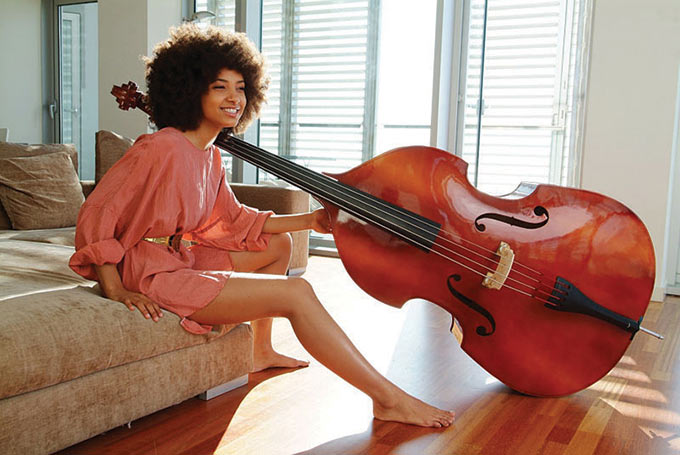The Esperanza Society
by Aidan Ryan

Jazz innovator Esperanza Spalding Kicks off new tour at UB
For several years now, there has been a crisis in jazz. But visitors to UB’s Center for the Arts on April 18, at 7:30pm, where jazz singer and bassist Esperanza Spalding will kick off her tour in support of her latest album, Radio Music Society, might taste that breath of fresh air that the genre has needed for so long.
As a form, jazz has been almost constantly in flux, reinventing itself at least once every decade since its hazy beginnings in the smoky brothels of Bourbon Street and the multicultural chaos of Congo Square. As jazz entered the 21st century, however, the form has stagnated: Neoconservatives like Wynton Marsalis, while still putting out good music, have attempted to turn back the clocks and preserve jazz as it was played by Louis Armstrong and Duke Ellington; free-jazz and jazz fusion artists have progressed little further than the innovations of Chick Corea in the 1970s and 1980s; and meanwhile the various intermarriages between jazz and every other musical genre under the sun have apparently been milked for all they are worth.
Enter Esperanza Spalding. The 27-year-old has been gaining attention both within the jazz world and beyond, and rightfully so. Becoming one of the youngest faculty members of Berklee College of Music immediately after graduating, and winning the Grammy Award for Best New Artist in 2011—the first jazz musician ever to do so—has put her on the map, so to speak, and earned her the praise of many older and established artists.
Spalding released her first album, Junjo, in 2006. Featuring Latin jazz covers and originals, the album wasn’t exactly breaking new ground, nor did it see meteoric success on the charts. Listening to it now, however, few can deny that the songs feel fresh.
Her eponymous second album, Esperanza, also featured Latin and Brazilian-influenced songs, but with a more pop-oriented, accessible feel. Once again, this ground had been covered before: Jazz and samba were first mixed by the visionaries Antonio Carlos Jobim and João Gilberto, and later given a pop spin in the mid-1960s by Sergio Mendes and Brasil ’66. What those pioneers lacked, however, Spalding has in spades. This element is funk, and nearly everything Spalding plays has a youthful energy and earthy groove that, in a different era, were inseparable from the wild, sex-crazed devil music called jazz.
Still, Spalding was flying under the radar until Chamber Music Society, released in 2010, took many by surprise. Her third album, and the one which gained enough mainstream attention to earn her the Best New Artist award at the 2011 Grammys, was something totally new. Unlike her previous releases, the album didn’t have much of a Latin feel, nor could it easily be described as funky. Instead, it combined jazz with classical chamber music.
Radio Music Society, her latest release, is the conceptual companion piece to Chamber Music.
On the surface, the two albums don’t sound very much alike. Chamber Music is at once more reserved and more dramatic, with thick string arrangements and fewer vocal numbers; it features Spalding’s ethereal scatting and is alternately lethargic and sublime. In a short, it’s luxuriously weird. Radio Music Society, conceived around the same time as Chamber Music, is much more pop-oriented and accessible, adding electric bass and guitar, as well as the youth horn section of the American Music Program and a slew of talented collaborators both famous and obscure.
That said, Spalding certainly didn’t compromise her artistic vision for accessibility. As she noted in a press conference last month, success hasn’t changed her approach to music: “We’re going to keep doing what we’re doing, but now we have more gigs.”
If anything, Radio Music is even more ambitious than Chamber Music. Spalding tackles the work of pop and jazz giants, reinterpreting Stevie Wonder’s “I Can’t Help It” and putting original lyrics to Wayne Shorter’s “Endangered Species.” She also draws from a wide range of genres, surpassing the former limits of what was known as jazz fusion. While there are definitely elements of fusion in the album, along with all the rock, funk, and virtuosity that the name implies, Spalding draws on everything from hip-hop to bebop, the result of which is often genre-less but always damn catchy.
Listeners on Wednesday night will no doubt be treated to an electric performance by top-notch musicians. As this will be their first performance of the national tour, the musicians will be bringing plenty of energy to the stage, and the performance will be nothing if not dynamic: Spalding knows as well as any veteran jazz cat that improvisation is the essence of jazz. On top of the hours of study and rehearsal, she says, “Everybody in the band has to be willing to dive into the unknown moments”—those microsecond confluences of inspiration, improvisation, coordination, and communication which make jazz what it is, and which give hope that the most American art form will continue to evolve.
blog comments powered by Disqus|
Issue Navigation> Issue Index > v11n15 (Week of Thursday, April 12) > The Esperanza Society This Week's Issue • Artvoice Daily • Artvoice TV • Events Calendar • Classifieds |









 Current Issue
Current Issue